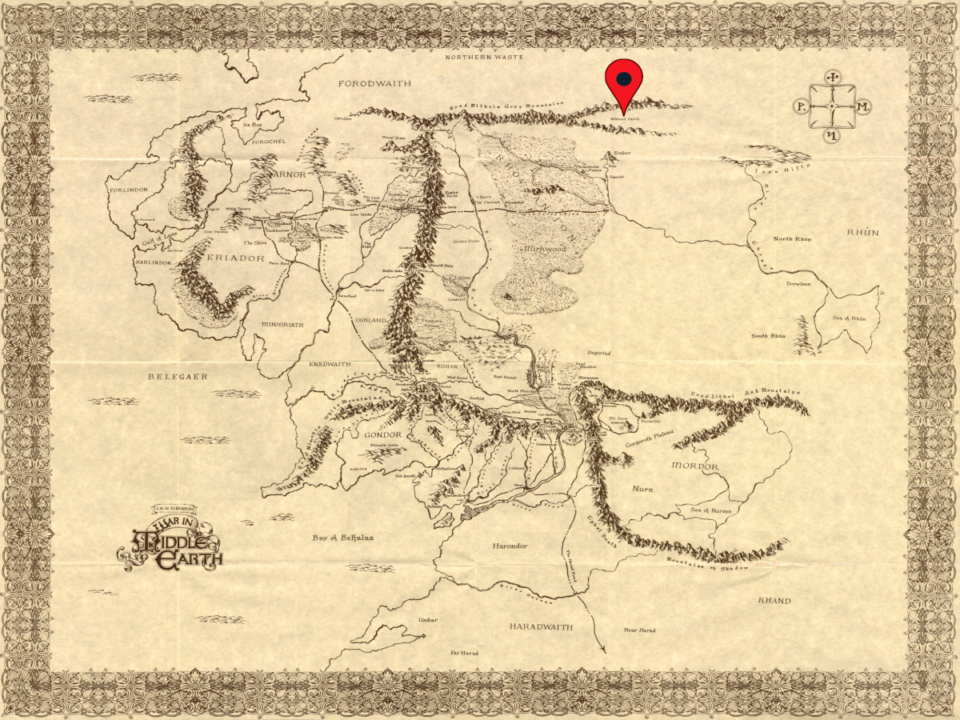Welcome back to everyone’s favorite www.isleyunruh.com Monday feature! Middle-earth being the place of enchantment and wonder that it is, each month I will use my love of fictional cartography to transport you to another time and place. So why not take a moment to fill your head full of knowledge that will have no bearing at all on the real world?
This month I’ll be looking at the desolate valley of The Withered Heath in the Grey Mountains to the North of Mirkwood.
“I don’t see that this will help us much,” said Thorin disappointedly after a glance. “I remember the Mountain well enough and the lands about it. And I know where Mirkwood is, and the Withered Heath where the great dragons bred.”
This quote from The Hobbit brings up the most interesting feature of the long (nearly 200 mile) valley located in the eastern half of the Grey Mountains (which split into two thin ranges above and below it): that it ended up becoming the breeding ground for the Dragons of Middle Earth for much of the Third Age. In the blasted wasteland of The Withered Heath, what little vegetation that covered the rocky ground thus became blackened and withered from the heat of the Dragons who dwelt there.
The Dragons did not actually originate in The Withered Heath, they were instead created in the pits of Angband long before the Third Age. Tolkien only specifically named four Dragons in his notes, and of these Glaurung, father of Dragons was the first, a product of some fell sorcery of Morgoth, with Ancalagon, greatest of all Dragons, one of Glaurung’s Angband offspring. Only Scatha (the great Long Worm who was slain by Fram of the Éothéod circa 2000 T.A.) and Smaug (who we all know from The Hobbit) originated from the Ered Mithrin (the Elvish name for the Grey Mountains).
It is unknown at what point the Dragons came to inhabit The Withered Heath, however, by the time the Dwarves had become settled in the Grey Mountains during the second millennium of the Third Age, many Dragons and Cold-drakes (Dragons without fire breath) had come to dwell there. By 2589 (with the deaths of Dáin I and his heir, Frór at the hands of an unnamed Cold-drake) the Dragons of the Withered Heath had completely driven the dwarves out. There is some speculation that the 4 lost Dwarven rings of power were either consumed or at the very least added to the Dragon hordes in those years.
Yet, by the time of the Hobbit 400 years later, Dragons were not one of the dangers mentioned by Gandalf as he discussed the perils of the Grey Mountains with Bilbo. My assumption is that the orcs who settled the region after the dwarves must have eventually been successful in driving the Dragons out.
However, orcs are base creatures, full of sloth and unthourough in their methods. Thus, who knows how many serpents still crawled the frozen plains of the Northern Wastes beyond the Grey Mountains at the time of The Lord of the Rings. Or how many still lay in hidden slumber upon a great horde of untold riches in some lost cavern beneath The Withered Heath–waiting for some thief bold enough to venture upon their horde and arouse their wrath once more!
That’s it for Middle Earth Monday this month! Join me the 4th Monday of next month as I take a look at The Gladden Fields!


5 Comments
Thanks goodness it wasn’t late this time!
Sigh.
**EDIT**
Crap! CRAP! twss! TWSS!!!!
It was right in front of me and I didn’t even notice it!!!
You twice spelled “Angband” as “Angbad”. Do you know something I don’t?
Actually, apparently you know something I don’t…I’ve always read it as “Angbad” apparently…EMBARRASSING!
Heh, thanks for the heads up though, I fixed it!
Yay. Another Middle Earth Monday. And a whole month to wait for the Gladden Fields. Le sigh.